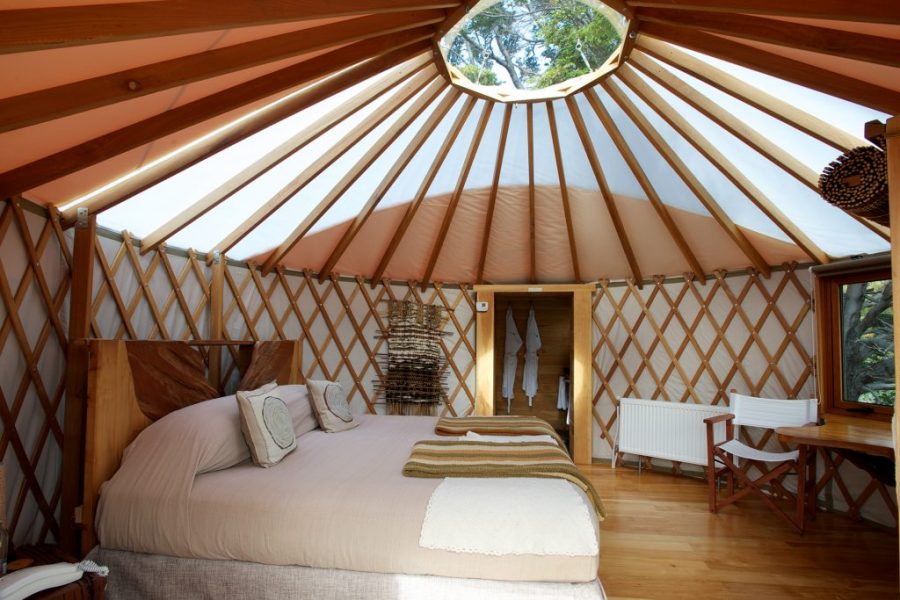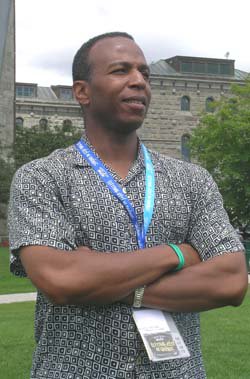A scenic three and a half to five-hour drive from Punta Arenas Airport (after a possible flight there from Santiago de Chile) depending on the wind, Patagonia, Chile in The Andes of Torres del Paine National Park, is on many a tourist’s bucket list. On the way from the airport, your van will pass near Tierra del Fuego, and Argentina. To explore Patagonia’s natural wonders, where September is the beginning of spring, Patagonia Camp Hotel’s 20 glamping yurts are forest finery for the active vacationer. Here you’ll find couples and families from the America’s and Europe, seeking the property’s curated excursions by vehicle or hike, fine dining, private jacuzzis, and special events such as familial styled pork roasts or classy wine tastes. Patagonia Camp offers a suite of day trips, dependent on your preference or level of fitness. The guides speak English and Spanish.
This is the one of the best luxury camps in South America. Pack sunglasses, hiking shoes, sunscreen, and gloves. Bring waterproof gear. The Camp supplies the rest, including health food or lunch, dried fruits for the day trips. Paine Massif Lookout is a full day which starts with a 20-minute drive to Grey Lookout for the beginning of your trail. You may be with other Camp groups. This choice is for those wishing to see Glacier Grey and the Ice Field. It is of medium endurance level. Be sure to ask for a trip that involves Cascade Paine, a Herculean waterfall that is life-changing in its force and sound.
A glimpse of the camp and startinf point of the Patagonia Trek >> BEST PLACES TO TRAVEL IN 2020 – TOP 7 GUIDE

Table of Content: Patagonia Trek: #1 The camp #2 Patagonia trek: excursions options #3 Photo safari #4 Camp Experiences #5 The skylight
Patagonia trek: 5 reasons to start at the Patagonia Camp
#1 The camp
The inspiration for yurts is Mongolian- they were the domiciles of nomads. At Patagonia Camp, the yurts have a conical shape we associate with spaceships. They are well heated, with a five-star decor, generous washroom and shower, bath and toiletry products, bathrobes, and electrical outlets. The yurts do not have WiFi, so there is access in the nearby Puma Room across from the front desk and restaurant. Upon arrival or the morning after, depending on your time of day. a guide will provide a slide show orientation of excursion options and other Camp details inside The Puma Room. This is also where you’ll assemble and dry pack your excursion lunch daily. Some light gear and apparel are sold here.
#2 Patagonia trek: excursions options
One of the great things about touring Torres del Paine is the variety of excursions available. For the most physically fit adventurer, the Base Torres Viewpoint Trek brings you with your group and guide, to the rocky base of the towering, sheer and jagged peaks known as The Torres (which means “Towers”). The difficulty level of this excursion is “High”. The Glacier Grey Viewpoint trek is also rated “High”, but those in decent condition (bikers, weekend athletes, weight trainers, swimmers) will find this well worth their while. There aren’t any drastic inclines, and depending on the calmness of the wind, this excursion is invigorating at best. It is a day trip of 22 KM, but there are breaks, including lunch. Its climax at Glacier Grey is a wonderful photo op, complete with icebergs. A moderate hike is called Lazo Weber. Hikers wind through the peaceful forests of Colque and Lenga, then up valleys and canyons where you’ll find frogs, ducks, and condor. At Onda Lagoon you’ll overlook Lake Calafate. It’s a perfect sightseeing tour for those who may not often hike or exercise, providing prime views of the Baguales mountains. the Contreras mountain range, and the Cuernos del Paine, a group of peaks whose name translates to “The Horns”. The trip includes lunch in the Western section of Torres del Paine park, then on to the Ciervo Lagoon, to The Toro Lookout- a payoff vista of Lake Toro, the Paine River, Serrano Valley, Mount Balmaceda, the Geike and Tyndall Glaciers, and the Southern Patagonia Ice Field. An added bonus of all the excursions is the fun education provided by your guide, about animals, their food chain, ancient inhabitants, natural formations which date back millions of years, and 19th and 20th-century explorers who came here from all over Europe.
Kedarkantha Trek: 6 day route review [2021]

#3 Photo safari
Even less rigorous is the Full Day Photo Safari, consisting of only 6 km, spread over eight hours, and designed to take guests to the ideally photogenic sites for flora and fauna. A full day Miradores hike encompasses Salto Grande Waterfall, which is quite the sight. This selection can be somewhat windy and is rated Low in rigor. Historical Patagonia has some challenging inclines, and a highlight is a display of 4,000-year-old cave art and handprints. Its degree is Medium-Low, and most days you will see puma, condor, guanaco (reminds of a llama) and other wildlife. There’s also a three-hour kayak trip and a low difficulty excursion to Milodon Cave (actually several caves). Back at the Camp for a delicious dinner with views of the mountains and yurts, you and your new friends will recount the viewing of icebergs, deer, and flamingoes, while you appreciate the sunset from the deck. The restaurant has a bar, and on chalkboard by the front desk, a roster of the next day’s activities and groups. Breakfast is a buffet with fruits, sausages, pastries, pancakes, and a soft, orange-hued carrot cake unlike any other. Afterward, you can hike the Camp’s own grounds, or trek to a nearby waterfall.

#4 Camp Experiences
Each Wednesday evening Patagonia Camp honors a Chilean family tradition by cooking lamb over an open hearth near The Puma Club, with a wine tasting. This is yet another opportunity to relax with fellow campers from everywhere. September 26-30 the Camp will host a yoga retreat for vacationers seeking commune with the nature of the region. There are two sessions per day. Late September is the beginning of spring in this part of the world. In November, the peak of spring, Patagonia Camp hosts a marathon, which attracts many annual guests, and includes some staff.
TOP 10 AFFORDABLE WINTER VACATION SPOTS IN 2020
# 5 The skylight
The nights are starry, best viewed not only from the deck of your lavish yurt but later, from the skylight above your comfy bed. Patagonia Camp is a paradise for the stressed. Morning yoga is offered, or sneak a peek at morning’s sunrise. You can fly fish, and there are romantic packages (honeymooners stay here). You’ll never want to leave the amiable staff. The best thing about all the new sights and sounds, friends and photos, is the stay is a perfect balance of unplugged wellness and active getaway. The combination of downtime in your private jacuzzi or hours on the trails is entirely up to you, and some days you may focus more on one than the other. It offers a complete escape from the everyday either way. A town you’ll enjoy en route back to Punta Arenas is charming, harbored Puerto Natales. Patagonia Camp offers round trips transfers to this village. While there, duck into The Coffee Maker cafe. The business also houses a sportswear and hiking apparel store. No matter your interests, your group size, the season or occasion, Patagonia Camp provides a lifetime of memories in three or five days.







